I am sure that we can all remember the carnival game of whack-a-mole; it had many variants but essentially a mole puppet would pop up out of a random hole and you had to quickly whack it on the head before it dropped back down. The more hits you have, the higher your score.
Trying to manage inflation via interest rate policy, is not that dissimilar to a game of whack-a-mole for central banks. Lifting interest rates is a very blunt tool, albeit the only one at this stage, as central banks try and whack businesses and consumers on the head with higher interest costs to get them to stop spending.
The reason it’s a blunt tool is that you are not sure how hard you have to strike and for how long. Strike too lightly and those pesky moles, in this case inflation, just keep popping up everywhere. Strike too hard and you may just break the machine – inflation may be controlled, but the game is broken for everyone else and takes a long time to repair.
Faced with downbeat headlines of rising recession risks, inflation and interest rates, markets have been volatile and with such a clouded economic outlook, all eyes focused on the recent round of corporate earnings. Heading into our second half 2022 earnings season, we preferred to take a cautious stance as we were simply not sure what impact, if any, rising interest rates were having on company earnings.
Australian Reporting Season
The following chart highlights the Australian reporting season results and it shows remarkable resilience to date with downgrades on par with the average and upgrades slightly ahead.
2H2022 Australian Reporting Season
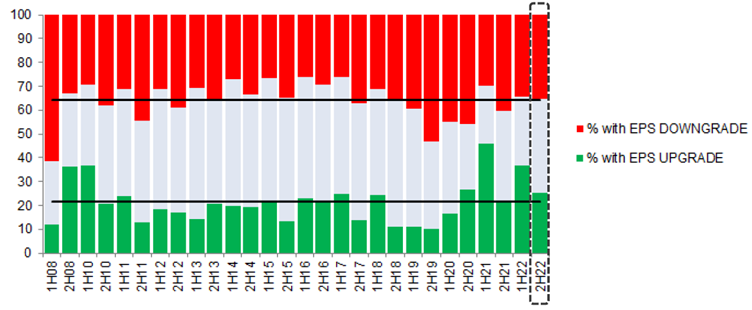
Source: Goldman Sachs Research August 2022.
While corporate costs have been climbing and hence partly why inflation has been rising, corporates have been able to pass on those costs, protecting their profit margins. The strong sales environment was highlighted by JB Hi-Fi – “As soon as stores reopened, it almost returned back to what it had been…. Online sales are elevated above levels from pre-Covid”. Temple & Webster also noted “Revenue per active customer growth, +6%, was a function of both growth in average order value and the repeat rate”.
The sales strength could be explained by our record low unemployment levels or perhaps our strong savings and the fact that the average home loan borrower is 22 months in front on repayments. While these are strong beneficial forces there are some headwinds, as indicated in the following chart of consumer confidence versus retail sales.
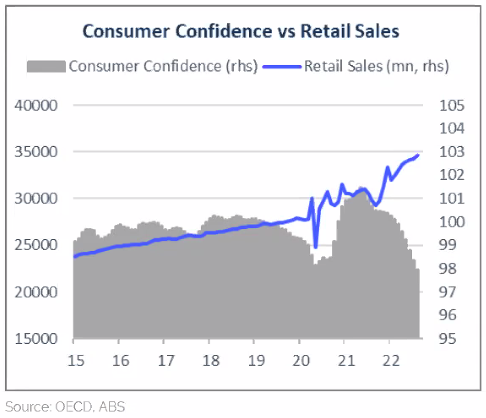
Theoretically, retail sales should follow consumer confidence. If consumers are less confident about future events, they tend to reduce or defer purchases and start increasing savings, a dynamic that the Reserve Bank of Australia (RBA) is relying on.
The chart above clearly shows that there is a dislocation between confidence and sales. We know that it is not simply a backlog of demand due to the covid lockdowns, as we can see that retail sales bounced strongly in 2020 as consumers switched to online sales.
Perhaps it is merely a time lag and that sales will start to trend back down in the coming months. The fact that consumers are in strong financial position could be creating a time lag. Another aspect is that while the RBA has lifted interest rates dramatically, as noted in the chart below, there simply has not been enough time for this to flow through the economy to cause a drag on consumption yet.
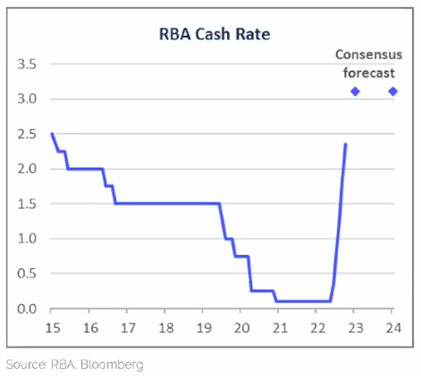
While the consumer is still spending for now, corporates are still facing severe labour shortages and are starting to brace for recession. In line with this, analysts are also lowering their expectations for earnings in the year ahead with materials and healthcare taking the largest hit as highlighted in the chart below.
FY23 net earnings revisions
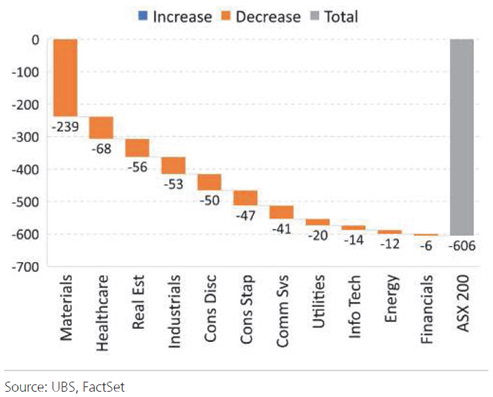
What does is all mean?
The outlook for the global economy is still murky and hard to predict with any clarity thanks to the emerging energy crisis in Europe, Covid zero lockdown in China and the somewhat unpredictable nature of inflation and the interest rate responses from central banks.
We continue to believe that Australia may once again dodge a recession simply because we have the commodities the world is in short supply of. Our unemployment remains at record lows and our consumers have entered this phase of the cycle in a strong financial position. It does not, however, mean that it will all be plain sailing and calm seas from here. There will be some bumps and our thesis does depend on how deep the recessions in the US and Europe will be.
In a binary sense, there appears to be two distinct outcomes – a benign outcome or one of bust. The following graphic best highlights what each of these outcomes mean for our economy.
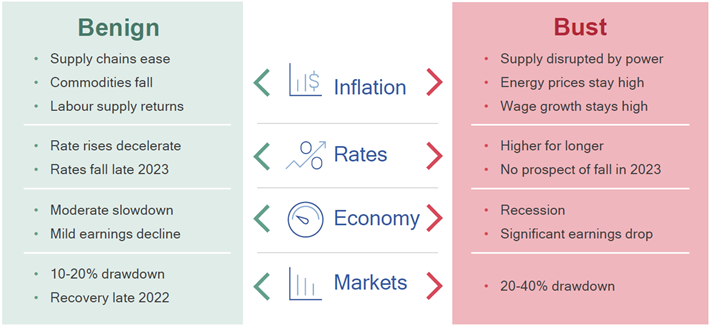
If we take the benign outcome, our equity markets have already corrected the required amount and interest rates may only rise another 0.50% or so. If, however, we assume the bust outcome, then we may face up to another 20% decrease in equity markets and interest rate increases of at least 2.00%.
We all know, however, that the real world is never that binary and that reality often resides somewhere between the two extreme outcomes. For this reason, we remain cautious on growth orientated assets and prefer a slightly more defensive stance in portfolios. This may mean that we will miss the early stages of any market upswing but given the prospect of the bust outcome, we believe it is better to try and preserve capital for now.
For more information contact us on 03 8610 6396
Keep Wealth Partners Pty Ltd (AFSL 494858)
This information is of a general nature only and may not be relevant to your particular circumstances. The circumstances of each investor are different, and you should seek advice from a financial planner who can consider if the strategies and products are right for you.







